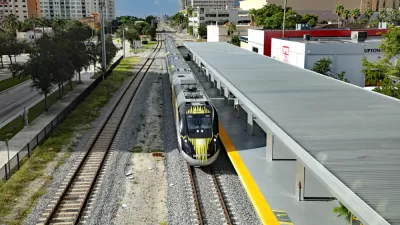A new academic study has determined that California's beleaguered high speed rail project may meet at least one promise if fully built - it can bring the environmental improvements that supporters boasted when travelers ditch planes and cars for HSR.
Meg McCabe reports on the new UC Berkeley/Arizona State University analysis of the environmental benefits that the public can expect if the now-initially funded high speed rail project is built and begins operation - which could be 20-30 years after next year's expected groundbreaking.
"UC Berkeley Professor Arpad Horvath and Arizona State University assistant professor Mikhail Chester authored the study, published (July 26) in the journal Environmental Research Letters, which evaluates the environmental and human-health impacts for the future of long-distance transportation."
"Even when you account for the life cycle effects, it's very likely that the development of the rail will help reduce greenhouse gas emissions," Chester said.
Sarah Yang, UC Media Relations, also reported on the just-released study.
"We're showing that if this high-speed rail system is deployed, it is likely that California will reduce its transportation environmental footprint," said Chester, who began this work as a UC Berkeley post-doctoral researcher. But to reap those environmental benefits, the state will have to wait until the system becomes fully operational, which could take an estimated 20-30 years after groundbreaking."
The authors write in the report's abstract:
"The environmental payback is most sensitive to the number of automobile trips shifted to high-speed rail, and for greenhouse gases is likely to occur in 20–30 years. A high-speed rail system that is deployed with state-of-the-art trains, electricity that has met renewable goals, and in a configuration that endorses high ridership will provide significant environmental benefits over existing modes."
Thanks to Reconnecting America
FULL STORY: California high-speed rail project will benefit state, study shows

Maui's Vacation Rental Debate Turns Ugly
Verbal attacks, misinformation campaigns and fistfights plague a high-stakes debate to convert thousands of vacation rentals into long-term housing.

Planetizen Federal Action Tracker
A weekly monitor of how Trump’s orders and actions are impacting planners and planning in America.

San Francisco Suspends Traffic Calming Amidst Record Deaths
Citing “a challenging fiscal landscape,” the city will cease the program on the heels of 42 traffic deaths, including 24 pedestrians.

Defunct Pittsburgh Power Plant to Become Residential Tower
A decommissioned steam heat plant will be redeveloped into almost 100 affordable housing units.

Trump Prompts Restructuring of Transportation Research Board in “Unprecedented Overreach”
The TRB has eliminated more than half of its committees including those focused on climate, equity, and cities.

Amtrak Rolls Out New Orleans to Alabama “Mardi Gras” Train
The new service will operate morning and evening departures between Mobile and New Orleans.
Urban Design for Planners 1: Software Tools
This six-course series explores essential urban design concepts using open source software and equips planners with the tools they need to participate fully in the urban design process.
Planning for Universal Design
Learn the tools for implementing Universal Design in planning regulations.
Heyer Gruel & Associates PA
JM Goldson LLC
Custer County Colorado
City of Camden Redevelopment Agency
City of Astoria
Transportation Research & Education Center (TREC) at Portland State University
Jefferson Parish Government
Camden Redevelopment Agency
City of Claremont




























